

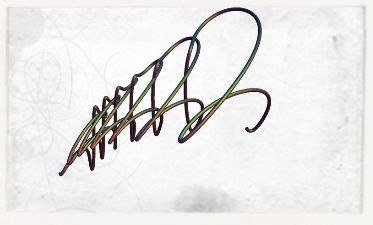
Accident math
CHARLIE
The LAPD accident analysis will tell
you how that happened, right?
DON
Thing is I got to find out why.
CHARLIE
That's tricky -- finding motives in
skid marks and trajectories.
DON
That's what I got you for, right?
An automobile accident leaves many physical traces of the events leading up to and during the crash: bent metal, paint scrapes, debris, rubber skid marks from tires braking and sliding, and shattered glass, in addition, of course, to the final resting location of each vehicle involved. So how can one go about reconstructing a traffic accident? Don and Charlie are faced with precisely this problem in Episode 402, "Velocity." In Episode 319, "Pandora's Box," Charlie used related techniques to model the debris distribution of an airplane crash site, in the process inferring that the plane had a larger mass than could be explained based on its declared cargo manifest.
Like airplanes, cars (whether driving smoothly, skidding, or colliding) are physical objects and obey the laws of physics. Rigid body mechanics, the conservation laws of classical mechanics, friction theory, and elasto- and plastomechanics all provide physical theories that can be incorporated into any model attempting to calculate the detailed process involved in an accident. Such calculation techniques are indeed used by police via dedicated computer programs that help analyze typical crash scenarios. The Society of Automobile Engineers organizes world congresses about accident reconstruction. Many of the contributed papers use the same mathematics that Charlie does.
Interestingly, one source of unexpectedly useful crash information is light bulb filaments (which includes halogen headlights but excludes LED headlights, as well as the LED taillights in recent BMW models). It just so happens that the filaments of everyday incandescent light bulbs are quite sensitive to accelerations of 20 to 50g (1g is the normal acceleration due to gravity at the surface of the Earth) over periods of around 100 milliseconds, which are precisely the sort of conditions encountered in typical accidents.
Friendship math
CHARLIE
That article I wrote, A Mathematical
Analysis of Friendship Dynamics?
DON
Yeah, yeah.
CHARLIE
McCadden Books want to publish it,
but not as a text book. As a
self-help book.
The hardest part about mathematically describing friendship is probably constructing a good model. A relatively simple model proposed by Julien Sprott in 2004 imagines the following scenario. Consider a love triangle in which Romeo and Juliet love each other, but Romeo also loves his mistress Guinevere and she loves him. Let RJ be Romeo's affection for Juliet, RG be Romeo's affection for Guinevere, J(t) be Juliet's affection for Romeo, and G(t) be Guinevere's affection for Romeo. Negative affection is interpreted as hate. Also let parameter a describe the extent to which Romeo is encouraged by his own feelings and b describe the extent to which he is encouraged by Juliet's feelings. With some further assumptions parameterized by additional variables c, d, e, and f (for more details, see papers by Sprott), the relation between the three people can then be modeled using the following set of coupled ordinary differential equations:
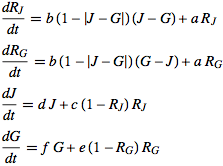
For particular choices of parameters, these equations can be solved using standard techniques and, in particular, using Mathematica's powerful built-in command NDSolve.
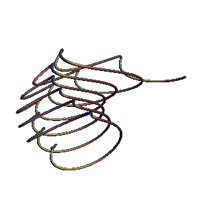
|
If we pick random values for the triangle members' initial affections for each other and assume that Romeo is moody in a periodic way (say because he has allergies in the spring, he's more irritable on Mondays, or he's in a great mood Friday nights at 10pm Eastern time), plug in values, solve the differential equations, and visualize the time-dependent attraction as curves in three-dimensional space, we can get a visualization such as the animation at left. Here, each frame shows how the feelings of the love triangle members evolve over time, and different frames sample different parts of the parameter space of Romeo's mood. |
|
Let us now continue to assume that Romeo has mood swings, but this time instead of taking them to be regularly periodic, we assume that his mood swings occur more or less randomly. We can immediately see a qualitative difference in the resulting solution, as illustrated at right. In fact, the resulting dynamics exhibit chaotic behavior, which is rather surprising for such a simple system of relationships (but then again, perhaps not so surprising given the inherent complexity of human emotions and interactions). |

|
We certainly don't intend this to be the last word on friendship dynamics, and look forward to seeing Charlie's insights Charlie will bring in his forthcoming book on the subject!
(More) accident math
CHARLIE
Dad, this is Dr. Ray Galinski. He's
helping me perform a mathematical analysis
of this crash here.
ALAN
(off computer graphics)
Where's the math? I just see a couple
of lines on a road.
GALINSKI
Embedded in the model.
CHARLIE
A computer simulation is just a
mathematical representation of the
real world. Sir Isaac Newton --
While the problem at hand is more one of mechanics than pure mathematics, Charlie has no trouble solving it. Historically, physics has initiated many important mathematical concepts. So Charlie keeps up with various areas of physics in order catch developments with potential mathematical ramifications. But to make sure he will not miss a crucial practical aspect, Charlie teams up with a mechanical engineer. And, as of today, mathematical papers about simple-looking mechanics regularly appear in top mathematical journals.
In this accident case Charlie is investigating, not all parameters are known because, as it turns out, not all cars are accounted for. So a detailed time-dependent calculation is quite difficult because Charlie would have to calculate many different accident scenarios and compare results with the real one. While possible with the help of large Monte Carlo calculations, Charlie instead decides to start with a much simpler approach: conservation laws.
While the conservation laws of mechanics seem simple at first glance, they reflect of deep properties of space and time such as Noether's symmetry theorem, a beautiful piece of mathematics created by mathematician Emmy Noether (who is almost certainly one of Amita's heros).
In the following, we will discuss the main physics laws that govern car accidents, focusing especially on the case of
two cars colliding. We all are familiar with the energy conservation theorem: energy cannot be destroyed, it can only
be transformed from one form to another. Electrical energy can be transformed into heat (as with an electric stove) or
mechanical energy (as with a blender). And as a result of Einstein's famous formula ![]() , we also know that mass and
energy are equivalent. In the case of two cars hitting each other, the kinetic energy of the two cars before the
collision will be equal to the kinetic energy after the collision plus the deformation energy that caused any bending or
tearing of metal, plastic, and glass of the cars. In the concrete scenario of a hit from the back while driving, the
deformation energy will be a relatively small fraction of the initial kinetic energy.
, we also know that mass and
energy are equivalent. In the case of two cars hitting each other, the kinetic energy of the two cars before the
collision will be equal to the kinetic energy after the collision plus the deformation energy that caused any bending or
tearing of metal, plastic, and glass of the cars. In the concrete scenario of a hit from the back while driving, the
deformation energy will be a relatively small fraction of the initial kinetic energy.
The second pertinent conservation law is the conservation of momentum. Billiard balls on a pool table show this conservation theorem very nicely. When a rolling ball hits a ball at rest straight on, the energy conservation theorem enforces the requirement that the balls have the same total kinetic energy after the collision as the single ball has by itself when it is initially rolling. While they could be moving in any direction and still fulfill energy conservation, as we all know, the initially rolling ball will stop and the originally motionless one will roll straight on in the direction of the originally moving one. The conservation of energy together with the conservation of momentum determine this behavior exactly.
Now let's express this toy collision mathematically. The kinetic energy K of a mass m moving with speed
v is given by ![]() . Because the collision is head-on and because one ball is resting, we can orient
our coordinate system such that we measure all velocities along the direction of the the initially moving ball. The
momentum p of a mass m moving with speed v is p = m v. So the two coupled
equations below describe relationship of the momentum and energy of the two billiard balls (assumed to be of equal mass)
before and after their collision.
. Because the collision is head-on and because one ball is resting, we can orient
our coordinate system such that we measure all velocities along the direction of the the initially moving ball. The
momentum p of a mass m moving with speed v is p = m v. So the two coupled
equations below describe relationship of the momentum and energy of the two billiard balls (assumed to be of equal mass)
before and after their collision.
![]()
![]()
Here, ![]() is
the speed of the first mass before the collision,
is
the speed of the first mass before the collision, ![]() is the speed of the second mass before the
collision,
is the speed of the second mass before the
collision, ![]() is the speed of the first mass after the collision, and
is the speed of the first mass after the collision, and ![]() is the
speed of the second mass after the collision. We ignore friction (for describing the behavior of the
billiard balls immediately before and after the collision, this is a good approximation).
is the
speed of the second mass after the collision. We ignore friction (for describing the behavior of the
billiard balls immediately before and after the collision, this is a good approximation).
(As a side remark, notice that the energy is quadratic in the velocity, which means that driving only 41% faster doubles the kinetic energy of the car and thus the potential damage to vehicles and people. Furthermore, the risk of dying in an accident is proportional to the fourth power of the speed, so driving 41% faster actually quadruples the risk of dying in any accident. Mathematical modeling of traffic is something that Charlie had done in earlier episodes, but this is another story. Be assured, Charlie will come back to these calculations later.)
Solving these equations gives two solutions:
![]()
In a real collision, a small fraction ε of the kinetic energy of two billiard balls is converted to heat through the microscopic elastic deformations of the balls. Quantitatively, this effect is in most cases taken into account through the quantity known as the restitution coefficient, which is defined as 1 - ε. Taking this loss into account results in more complicated solutions.
![]()
For practical purposes, one does not need the complicated square roots, but a series expansion for small ε is sufficient. There are two solutions: the first describes the case where no collision happens and the two billiard balls roll on as before (which is not of interest here), and the second is for the collision where the two balls interchange their velocities.
Real cars are not just mass points they are 3D objects. The physics of such objects is covered by rigid body mechanics.
The main addition of relevance for rigid bodies as compared to just point masses is the fact that rigid bodies can
rotate and the relevance of angular momentum for a body as a whole L = r × p, where r
is the center of mass of the body and p is its momentum, and the inner angular momentum due to rotation L
= J ![]() , where J is the moment of inertia and ω is the angular velocity.
, where J is the moment of inertia and ω is the angular velocity.
In this case, we can no longer model the problem purely one-dimensional. We need at least two dimensions (meaning the objects that will collide are moving in a plane) where the colliding billiard balls roll. In the simplest case, we assume that the balls were not rotating before the collision and there there are no tangential forces between the colliding balls. But the two balls carry out a noncentral collision. In this case, the balls will not be spinning after the collision either.
For simplicity of the formulas, let's choose the origin of the coordinate system so that the point of collision is {x,y}. Because we ignore rotations of the two balls for now, the angular momentum to take into account is the one of the two billiard points around the collision point. The angular momentum L=r×p of the moving body is a vector pointing of of the plane of their movement and we consider only the out-of-the-plane-pointing component.
The solutions now grow more complicated, and a simulation is shown below.
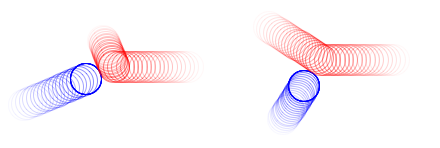
Charlie also needs to take friction between colliding cars into account. A detailed description of friction is a complicated mathematical undertaken. Typically, one differentiates between static and kinematic friction. The interplay between the two types can be nicely observed by balancing a ruler on the two index fingers hold horizontal and moving the two fingers slowly together. The ruler will not fall, but alternately slide on the left/right finger. For a tire, rolling fraction coefficients and the direction of rolling/slipping are the two most-important parts. And the typically assumed to be constant friction coefficients become velocity dependent for rubber tires.
An interesting and not much known concept that Charlie has to take into account here is the jerk. The jerk is the third derivative of a position. We are well-familiar with the first derivative (velocity) and the second derivative (acceleration). But for rolling tire and steering related phenomena, the third derivative is of importance too.
The next step for Charlie to include on the way for a realistic modeling of the car collision is the internal angular momentum. A rigid body has internal angular momentum given by L = J ω, where J is the well-known moment of inertia tensor, defined by
![]()
where ρ(x,y,z) is the local mass density.
For a homogeneous sphere, one gets ![]() where M is the mass of the sphere and R is its radius.
where M is the mass of the sphere and R is its radius.
Depending on the actual impact angle at the collision, there might have been a considerable tangential force between the two cars. As a result, the cars would have started to spin around. (Meaning part of the original kinetic energy is now rotational energy).While billiard balls to not show much tangential force (very small tangential friction), a superball does have a large tangential friction. As a result, superballs can bounce back in the direction from where they were thrown. See the demonstration
In the ball models, one would now have to add equations enforcing nonslipping. These additional equations allow to solve for the two additionally present variables, the angular velocities of the balls after the collision.
Another daily-life example where the coupling between translational motion and rotational motion matters (no collision involved here) is a sliding rotating penny. Even for an idealized version of this very simple system, one obtains quite complicated equations of motion, involving elliptic integrals.
To express things mathematically, the energy conservation must now include the rotational energy of the two balls and the angular momentum equations must include the internal angular momentum of the two balls. The equations become more complicated again.
To model a car hit realistically, Charlie has to go on: For an asymmetric body, the moment of inertia must be generalized to a tensor (assuming the center of mass coordinate system)

Modeling a car as a box with edge length a, b, c, we get
![]()
![]()
Because of the symmetry of the chosen brick and the orientation of the chosen coordinate system we obtained a diagonal matrix. And symmetric matrix, meaning any moment of inertia tensor can be transformed to diagonal form. This form gives three directions.
The rotation around the directions with the smallest and the largest moment are stable, the intermediate one is unstable. (Try to rotate a brick stably around its three axes.)
Because of the approximate left-right and front-back symmetry of a real car, the roll, pitch, and yaw moments of inertia are sufficient to model the full inertia tensor of a car.
The case of an additional mass in the trunk could be modeled through the above definition of the angular momentum tensor by adding a term contributing to the additional mass. At the moment of the car collision, the momentary rotation point is not on the center of mass of either cars, so Charlie will use the so-called Steiner theorem to obtain a new moment of inertia tensor.

The case of an additional mass in the trunk could be modeled through the above definition of the angular momentum tensor by adding a term contributing to the additional mass. At the moment of the car collision, the momentary rotation point is not on the center of mass of either cars, so Charlie will use the so-called Steiner theorem to obtain a new moment of inertia tensor.
So far, the calculations involving just the conservation laws were giving some larger results, but were still relatively easy to solve. After getting some crude estimations of the happening at the accident, Charlie goes on and carries out some time-dependent calculations. Already the modeling of a purely rotating 3D body becomes quite complicated. The archetypical system are Euler's equations for a rigid body with no external forces. (These equations are in a very special coordinate system, the equations describing the angular velocities in the street coordinate system are substantially more complicated and are obtained by using the so-called Euler angles.)
![]()
Notice that compared with the above equations, they are genuinely nonlinear. Using some of the most-complicated complicated special functions of mathematical physics, called theta functions. One can solve these equations in closed form. In a realistic accident scenario, angular momenta due to lateral tire friction have to be taken into account.
![]()
The resulting system of coupled nonlinear differential equations cannot be solved analytically anymore, but can be easily solved numerically. The resulting solutions can get very complicated. Here are some examples.

And although this system of equations is about two hundred years, old, still some new insights can be found even today. Just recently some unknown features of these equations were found by considering the angular velocities as complex variables (something that physicists love to do).
We are glad that Charlie had some Earthy conditions to solve this problem. Glad Larry did not have to deal with this when he was on the ISS. His ex-coworker, astronaut Michael Foal had to solve these equations while the space station was tumbling.
Because the frames of the cars were not very damaged in the collision, Charlie did not have to make a full-scale finite element calculation of the deformations of the metal. But one larger part that he still had to take into account was steering and the rolling wheels. The well-known Newton's second law F=m a is not enough to calculate rolling wheels. Because rolling wheels are nonholonomic constraints. Simplified speaking, in the case of wheels this means that a rolling wheel must locally roll in its direction, but globally, it can change its direction. Taking the so-called D'Alembert's principle into account, such nonholonomic systems can be treated too. The equations become quite a bit more complicated again. Even in the case of a single rolling wheel. Here are some pictures showing frames of a single wheel rolling on a plane. Dissipating friction is ignored and gravity is taken into account. A rolling coin is a first approximation for this ideal situation.

In general, nonholonomic constraints are a fascinating part of classical mechanics and still a topic of modern research. Many counterintuitive mechanical movements, such as the rotation-inverting rattleback are described by nonholonomic constraints.
Charlie also has to take into account some details of the collision forces. Fortunately, in the case of a hit from behind, most of the force was transmitted through the bumper and a simple phenomenological force law of the form
![]()
In the coordinate of the hit car, this equation can be solved exactly to give:
![]()
![]()
Newton's laws and the law of universal gravitation
In "Velocity," Charlie describes use of a computer model to analyze the mechanics of an automobile crash. In response to Alan's question, "Where's the math?" Charlie invokes the famous fable of Sir Isaac Newton and the falling apple.
CHARLIE (O.S.)
He observed a real world event--gravity.
The APPLE falls from the tree.
CHARLIE (O.S.) (cont'd)
He then created a mathematical model
to represent that phenomenon.
The APPLE stops mid-air. GRAPHIC overlay displays Newton's
equations of motion and the law of universal gravitation.
CHARLIE (O.S.) (cont'd)
Which he could then extrapolate to
predict the orbits of planets-
the general structure and movements
of galaxies.
Newton was a titan of mathematics and science. He made innumerable fundamental contributions to mathematics and physics, among which are his three famous laws of mechanics:
Newton's life and work are covered in great detail by many works, including the excellent biographies by R. S. Westfall. There is much more that could be said about Newton. However, the additional fundamental result of Newton we wish to discuss here briefly is his famous law of universal gravitation. This law states that the gravitational force between two masses m1 and m2 separated by a distance r is given by the following expression, where G is a constant of nature now known as the gravitational constant:
In other words, the gravitational force between two masses is proportional to the product of their masses and inversely proportional to the square of their separation. It is an important yet underemphasized fact that this law is fundamentally different from Newton's other three "laws" of mechanics. Newton himself referred to them not as laws, but as axioms in his Principia Mathematica. In particular, the three laws do not allow the calculation of any forces (except for net force) in the absence of any other information about a physical system. In contrast, the law of gravitation led for the first time to the calculation of a fundamental force. For more fascinating epistemological details, see the 2001 paper by Newburgh.
Friction circles
GALINSKI
Problem is, our model doesn't
match reality. Car's not crashing.
CHARLIE
It's not the Friction Circle
expressions, right? I mean they seem
dead on.
ALAN
Friction Circle Theory? Planners use
it to analyze soil slope stability for
building foundations.
GALINSKI
One and the same, my friend.
It has experimentally found that the tires of a car (or truck, motorcycle, etc.) can pull a fixed maximum magnitude of acceleration beyond which slipping occurs. Stated another way, it has been found that the maximum value of the net friction force on a tire is independent of its direction in the plane of the tire. Note that while "acceleration" is typically thought of a scalar quantity (i.e., a quantity having magnitude only but no direction associated with it), acceleration is actually a vector quantity, having both magnitude and direction. An acceleration in the forward direction corresponds to speeding up (colloquially termed simply "acceleration", typically caused by depressing the gas pedal), while an acceleration in the reverse direction corresponds to slowing down (termed "deceleration", typically caused by breaking). However, lateral accelerations also occur while rounding a turn (termed "cornering").
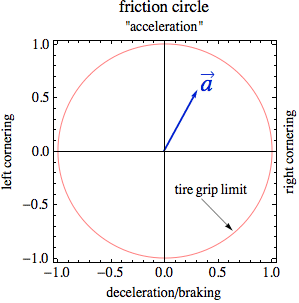
The friction circle concept, first popularized in the 1960s, simply expresses the experimental fact that a tire will grip as long as the norm (the more technical mathematical term for "magnitude" when applied to a vector) of the overall acceleration it experiences is less than some maximum value, above which it will slip:
In other words, if the acceleration vector representing the net combination of accelerations (from cornering, acceleration, and braking) lies within the friction circle, the tire will grip; otherwise, it will slip. Note that value of the maximum acceleration above which slipping occurs depends on a number of factors, including the tire tread and material, the composition and surface characteristics of the road, as well as the presence of contaminants such as water and oil on the road. Water and ice in particular affect the size of the friction circle, reducing it in radius by something like 70% for wet roads or even up to 90% for icy roads.
The friction circle reflects the intuitive facts that a strongly accelerating vehicle cannot turn laterally with slipping, and that a car taking a sharp corner cannot accelerate straight ahead without also slipping. Understanding these processes is important, since if you you are simultaneously braking and cornering, hitting a small bump can easily cause am unrecoverable skid, which may in turn lead to a crash. It's therefore not surprising that friction circles are actually used in real-world research by automobile manufacturers in the study and attempt to improve the performance of vehicle steering and breaking systems.
As Alan notes, there is also a method known as the circle-method that has been commonly been used for the stability analysis of slopes. This method was first proposed by Gilboy as early as 1932 and is based on the condition of equilibrium of forces and the condition that actuating and resisting forces are concurrent. Without going into too many details, it is not apparent that this methods bears any real connection to the circle method applied to tires, Galinski's statement notwithstanding.
GALINSKI (cont'd)
Okay, so you know that when a car
takes a turn, the wheels don't all
turn at the same speed.
CHARLIE
It's a phenomenon related to
centripetal force --
Centripetal acceleration is the acceleration a body undergoes when it is "at rest" in a rotating non-inertial
frame of reference. A body rotating with angular velocity ![]() at a radius r from the rotation center at position
r(t) = (x(t), y(t)) has Cartesian coordinates
at a radius r from the rotation center at position
r(t) = (x(t), y(t)) has Cartesian coordinates
![]()
The acceleration is given by the second derivative
of the position vector, so
![]()
where the double dot is Newton's notation for the second time derivative of a quantity in his original theory of differential
calculus (which he called a fluxions)--a notation that
is still in widespread use today.
In other words,
![]()
and the magnitude of the acceleration is
![]()
If the angular acceleration ![]() and position r are treated as vector quantities from the
outset, then the centripetal acceleration is given by
and position r are treated as vector quantities from the
outset, then the centripetal acceleration is given by
![]()
Writing ![]() in
terms of the tangential velocity
in
terms of the tangential velocity ![]() , the equation now becomes the familiar
, the equation now becomes the familiar
![]()
which is negative because the acceleration is directed inward.
By Newton's second law, F = ma, so a force must be applied in order to keep a body in circular motion and prevent it from flying away. This force is known as the centripetal force. In the case of a planet orbiting the sun, the centripetal force is provided by gravitational attraction between the sun and planet. In the case of a car cornering a turn, the force is provided by the friction of the tire on the road.
References
Arredi, F. "A Reexamination of the Friction Circle Method for the Stability Analysis of Slopes" Meccanica 1, 48-68, 1966.
Lopez, C. "Breaking and Entering." Ch. 5 in Going Faster!: Mastering the Art of Race Driving. Cambridge, MA: Bentley Publishers, 2001. http://www.bentleypublishers.com/gallery.htm?code=GDBA&galleryId=831
Murthy, V. N. S. "Friction-Circle Method." &sec; 10.10 in Geotechnical Engineering: Principles and Practices of Soil Mechanics and Foundation Engineering. Boca Raton, FL: CRC Press, pp. 382-385, 2002.
Newburgh, R. "Why isn't the Law of Gravitation Called Newton's Fourth Law?" Phys. Educ. 36, 202-206, 2001.
Ono, E.; Hattori, Y.; and Muragishi, Y. "Estimation of Tire Friction Circle and Vehicle Dynamics Integrated Control for Four-Wheel Distributed Steering and Four-Wheel Distributed Traction/Breaking Systems." R&D Review if Toyota CRDL 40, 7-13, No. 4. http://www.tytlabs.co.jp/japanese/review/rev404pdf/404_007ono.pdf
Sprott, J. C. "Dynamical Models of Love." Nonlin. Dyn., Psych., Life Sci. 8, 303-313, 2004. http://sprott.physics.wisc.edu/pubs/paper277.pdf
Sprott, J. C. "Dynamical Models of Happiness." Nonlin. Dyn., Psych., Life Sci. 9, 23-36, 2005. http://sprott.physics.wisc.edu/pubs/paper281.pdf
Taylor. Fundamentals of Soil Mechanics. New York: Wiley, pp. 441-448, 1948.
Westfall, R. S. The Life of Isaac Newton. Cambridge, England: Cambridge University Press, 1994.
Westfall, R. S. Never at Rest: A Biography of Isaac Newton. Cambridge, England: Cambridge University Press, 1988.